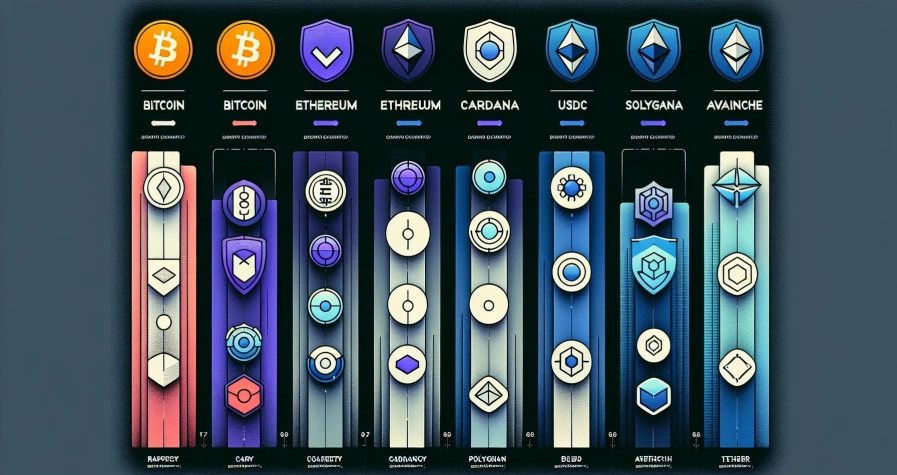Key Takeaways
- ICOs are digital fundraising mechanisms that allow blockchain startups to raise capital by selling newly created tokens directly to global investors, bypassing traditional intermediaries and regulatory approval processes required for conventional IPOs.
- Token types determine functionality and regulation – utility tokens provide access to platform services, security tokens represent ownership stakes subject to securities laws, and governance tokens offer voting rights on project decisions.
- High-risk, high-reward investment landscape exists with ICOs, where over 90% of projects fail within two years, yet successful campaigns like Ethereum have generated billions in value and transformed entire industries.
- Regulatory frameworks vary dramatically worldwide – from complete bans in China and South Korea to developing comprehensive regulations in the US and EU, creating compliance challenges and investment uncertainties for participants.
- Due diligence is crucial for investors as the largely unregulated ICO environment enables fraud and scams, with studies showing 80% of 2017 ICOs were fraudulent schemes, making thorough project evaluation essential.
- ICOs offer unique advantages over traditional fundraising including global accessibility, rapid capital deployment, lower costs, and immediate token liquidity, though these benefits come with reduced investor protections and regulatory oversight.
You’ve probably heard whispers about ICOs revolutionising how startups raise capital, but what exactly are these digital fundraising mechanisms that captured headlines and billions in investment? An Initial Coin Offering represents a groundbreaking approach to crowdfunding that’s transformed the cryptocurrency landscape since 2017.
ICOs allow blockchain projects to raise funds by selling newly created digital tokens directly to investors worldwide. Unlike traditional IPOs that require extensive regulatory approval and intermediaries, these offerings democratise investment opportunities whilst giving early supporters potential access to innovative technologies.
Whether you’re considering investing in an ICO or simply want to understand this crucial crypto concept, you’ll need to grasp both the opportunities and risks involved. From regulatory challenges to spectacular successes and failures, ICOs have shaped the modern blockchain ecosystem in ways that continue influencing how we think about digital finance and decentralised funding models.
What Is an ICO (Initial Coin Offering)?
An Initial Coin Offering (ICO) is a fundraising mechanism where blockchain startups issue digital tokens to investors in exchange for cryptocurrency or fiat currency. You’re essentially purchasing newly created tokens that represent various utilities within the project’s ecosystem rather than traditional equity ownership.
ICOs operate through smart contracts on blockchain platforms like Ethereum, which automate the token distribution process. Your investment typically involves sending established cryptocurrencies such as Bitcoin (BTC) or Ether (ETH) to the project’s designated wallet address. The smart contract then releases the corresponding amount of new tokens to your digital wallet based on predetermined exchange rates.
The tokens you receive serve different purposes depending on the project’s design:
- Utility tokens grant access to specific services or features within the platform
- Security tokens represent ownership stakes or profit-sharing rights in the underlying business
- Payment tokens function as digital currencies for transactions within the ecosystem
- Governance tokens provide voting rights on project decisions and protocol changes
ICO campaigns typically follow a structured timeline with distinct phases. Pre-sale periods offer early investors discounted token prices, often 20-50% below the public sale price. The main sale phase opens to all participants and may feature bonus structures that decrease over time. Token generation events (TGE) mark the technical creation of tokens, while token distribution events (TDE) handle the actual transfer to investor wallets.
| ICO Phase | Duration | Typical Discount | Minimum Investment |
|---|---|---|---|
| Private Sale | 2-4 weeks | 30-50% | £10,000-£100,000 |
| Pre-sale | 1-2 weeks | 15-30% | £500-£5,000 |
| Public Sale | 2-8 weeks | 0-15% | £50-£500 |
Your participation requires completing know-your-customer (KYC) and anti-money laundering (AML) verification processes in most legitimate ICOs. Projects publish detailed whitepapers outlining their technical specifications, business models and token economics before launching their campaigns. These documents serve as your primary source for evaluating investment opportunities and understanding the project’s long-term viability.
How ICOs Work
ICOs operate through a structured fundraising process where blockchain projects create and sell digital tokens to investors in exchange for established cryptocurrencies like Bitcoin or Ethereum. Companies bypass traditional funding routes such as venture capital or bank loans by offering tokens that provide utility within their ecosystem or represent project stakes.
The ICO Process Explained
Your participation in an ICO follows several key phases that projects implement to maximise fundraising success. Companies first define their fundraising goals and determine token structure including total supply and pricing methods which may remain fixed or adjust dynamically based on campaign performance.
The process begins when projects prepare promotional materials and whitepapers to attract potential investors. Marketing campaigns launch primarily through online channels to publicise the ICO though major platforms often restrict cryptocurrency advertisements. Projects create comprehensive documentation outlining their technology roadmap business model and token utility to establish credibility with investors.
During the token sale phase you purchase tokens using legal tender or established cryptocurrencies with transactions processed through smart contracts that automatically distribute tokens upon payment confirmation. ICO campaigns typically structure sales across multiple phases including private rounds for institutional investors pre-sales offering early-bird discounts and public sales open to retail participants.
Token Creation and Distribution
Token generation occurs through blockchain platforms with Ethereum being the most popular choice due to its established smart contract infrastructure. Projects modify existing code rather than building entirely new cryptocurrencies making token creation relatively straightforward and cost-effective.
Created tokens represent digital assets or utilities on the blockchain and remain fungible and tradable assets. Unlike traditional shares these tokens generally don’t confer equity ownership in the company but instead provide access to platform services or governance rights within the project ecosystem.
Distribution happens automatically through smart contracts once you complete your purchase with tokens allocated to your wallet address according to sale agreements. After the ICO concludes tokens become available for trading on cryptocurrency exchanges where their market value fluctuates based on project development and investor sentiment.
The entire process operates with limited regulatory oversight which creates both opportunities for innovation and risks including potential fraud. Many ICO projects fail shortly after launch though successful campaigns have raised billions of dollars for blockchain initiatives globally.
Types of ICO Tokens
ICO tokens fall into distinct categories that determine their function and regulatory treatment within blockchain ecosystems. Understanding these token types helps you evaluate investment opportunities and compliance requirements effectively.
Utility Tokens
Utility tokens grant you access to specific products or services within a blockchain platform’s ecosystem. These digital assets function as vouchers that unlock platform features rather than representing ownership stakes in the issuing company.
You can use utility tokens to:
- Access platform services like cloud storage or computational resources
- Pay transaction fees within decentralised applications
- Participate in network governance through voting mechanisms
- Unlock premium features in blockchain-based platforms
Utility tokens aren’t designed as traditional investments but as functional tools for interacting with digital ecosystems. Companies issue these tokens to create network effects and incentivise early adoption of their platforms.
Security Tokens
Security tokens represent ownership rights or financial interests in a company, making them subject to securities regulations in most jurisdictions. These tokens provide you with traditional investment benefits whilst leveraging blockchain technology for issuance and trading.
Security tokens offer several advantages:
| Feature | Traditional Securities | Security Tokens |
|---|---|---|
| Trading Hours | Limited market hours | 24/7 trading capability |
| Settlement Time | 2-3 business days | Near-instantaneous |
| Geographic Access | Restricted by jurisdiction | Global accessibility |
| Fractional Ownership | Limited availability | Easily divisible |
You may receive dividends, voting rights, or profit-sharing arrangements when holding security tokens. However, companies must comply with regulatory frameworks like those enforced by the US Securities and Exchange Commission, significantly increasing compliance costs and limiting security token issuance to well-funded startups.
Security tokens require extensive legal documentation and regulatory approval processes before launch, contrasting sharply with the relatively unrestricted nature of utility token offerings.
Benefits of ICOs for Startups
Rapid Access to Global Capital
ICOs enable startups to access funding quickly without traditional financial intermediaries. You can raise capital within weeks rather than months compared to conventional venture capital rounds. Blockchain projects using ICOs have raised over $30 billion globally since 2017, demonstrating the mechanism’s effectiveness for rapid capitalisation. Your startup can attract investment from anywhere in the world since cryptocurrency transactions transcend geographical boundaries and banking restrictions.
Cost-Effective Fundraising Structure
You eliminate expensive intermediaries like investment banks, brokers, and underwriters that typically charge 5-7% of total funds raised in traditional IPOs. ICO platforms charge between 1-3% in fees, significantly reducing your fundraising costs. The absence of extensive legal documentation requirements found in traditional securities offerings further reduces legal expenses by 60-80% compared to conventional funding methods.
Flexible Token Distribution Models
Your startup can design customised fundraising structures tailored to specific project requirements. You might implement pre-sales offering 20-30% token discounts to early investors, followed by public sales at standard pricing. Multiple sale phases allow you to test market demand whilst building community engagement before full token distribution. This flexibility extends to funding targets, where you can set minimum and maximum caps based on project development needs.
Regulatory Flexibility and Speed
ICOs often bypass traditional securities regulations that require extensive compliance documentation and regulatory approval processes. You can launch token sales without the 6-12 month regulatory review periods required for traditional public offerings. This regulatory flexibility allows faster market entry, though regulatory landscapes are evolving with increasing government scrutiny in jurisdictions like the United States and European Union.
Community Building and Marketing Integration
Token sales create engaged communities of stakeholders invested in your project’s success. Early investors become project advocates, providing organic marketing through social media channels and cryptocurrency forums. You benefit from network effects as token holders promote adoption to increase token value, creating self-reinforcing growth cycles that traditional fundraising methods cannot replicate.
Liquidity for Tokens and Investors
Your tokens can trade on cryptocurrency exchanges immediately after ICO completion, providing liquidity for early investors. This tradeable nature attracts more investors compared to traditional startup equity that remains illiquid for years. Secondary market trading creates price discovery mechanisms and ongoing fundraising opportunities through additional token releases or strategic partnerships with exchanges.
Risks and Challenges of ICOs
ICOs operate with significant risks that you must carefully evaluate before investing. These fundraising mechanisms face regulatory uncertainties and investment vulnerabilities that can result in substantial financial losses.
Regulatory Concerns
You face substantial regulatory uncertainty when participating in ICOs across different jurisdictions. The U.S. Securities and Exchange Commission has taken enforcement action against ICO projects violating securities laws, while other countries impose complete bans or heavy restrictions on token sales.
Regulatory frameworks vary dramatically between nations, creating compliance challenges for both project founders and investors. You might encounter legal complications if the ICO you’ve invested in becomes subject to retrospective regulatory action or classification changes.
The lack of standardised regulations means you can’t rely on consistent investor protections typically available in traditional securities markets. Projects operating in this unregulated environment often struggle to achieve long-term legitimacy without proper legal foundations.
Investment Risks
You’re investing in highly experimental projects when participating in ICOs, as many operate at early development stages without proven technology or working prototypes. These blockchain ventures often feature untested business models that may never achieve market viability.
Token prices exhibit extreme volatility with no guaranteed liquidity or future value retention. You might find yourself holding tokens that become worthless if the project fails to deliver on its promised roadmap or faces technical difficulties.
Whitepapers replace formal prospectuses in ICO investments, yet these documents can be incomplete, biased or misleading. You require sophisticated technical understanding to properly evaluate these projects, as traditional financial analysis methods don’t apply to token economics.
Many ICO projects fail within months after launching, with studies showing high failure rates across the industry. You face the risk of total investment loss, as tokens often lack backing by tangible assets or guaranteed returns.
Fraud and scams exploit the pseudonymous nature of blockchain technology, with exit scams occurring when project founders disappear with investor funds. The decentralised structure makes recovery of lost investments extremely difficult through traditional legal channels.
ICO vs Traditional Fundraising Methods
ICOs operate differently from traditional fundraising methods in several fundamental ways. You can access ICO investments globally without geographic restrictions, whilst traditional fundraising typically limits participation to accredited investors or those within specific jurisdictions. The regulatory framework differs significantly between these approaches, with ICOs generally operating under minimal oversight compared to the strict compliance requirements of venture capital or IPO processes.
The speed and cost advantages of ICOs become apparent when you examine the fundraising timeline. ICOs can launch within weeks of preparation, allowing projects to raise capital rapidly without lengthy approval processes. Traditional fundraising methods require months or years of due diligence, regulatory filings, and intermediary involvement, increasing both time-to-market and overall costs.
Regulatory Differences
You encounter vastly different regulatory environments when comparing ICOs to traditional fundraising. Traditional methods operate under established securities regulations with mandatory disclosures, investor protections, and legal oversight. ICOs function in a largely unregulated space, varying significantly by jurisdiction, which creates both opportunities and risks for participants.
Regulatory compliance costs for traditional fundraising can reach hundreds of thousands of pounds, whilst ICO projects often launch with minimal legal expenses. However, this reduced oversight increases your exposure to fraudulent schemes, with studies showing that over 80% of ICOs conducted in 2017 were identified as scams.
Ownership and Investment Structure
Traditional fundraising grants you equity ownership in exchange for capital, providing voting rights and potential dividend payments. ICO tokens typically offer utility access or speculative value rather than company ownership, fundamentally changing your relationship with the project.
| Feature | ICOs | Traditional Fundraising |
|---|---|---|
| Ownership rights | No equity; utility or speculative tokens | Direct equity stakes with voting rights |
| Investor protections | Limited regulatory oversight; high fraud risk | Comprehensive legal protections and disclosures |
| Market access | Global retail and institutional investors | Primarily accredited investors initially |
| Funding speed | Days to weeks for campaign launch | Months to years for completion |
| Regulatory costs | Minimal legal requirements | Extensive compliance and filing fees |
Risk and Return Profiles
You face different risk-return scenarios with each fundraising method. ICOs offer potential for significant returns if tokens appreciate in value, but carry substantial risks including project failure, regulatory changes, and market volatility. Traditional fundraising provides more predictable risk assessment through established due diligence processes and financial auditing requirements.
The failure rate of ICO projects exceeds 90% within two years of launch, whilst traditional venture capital investments show approximately 75% failure rates. These statistics reflect the experimental nature of many blockchain projects and the reduced vetting processes in ICO fundraising.
Market Accessibility and Liquidity
ICO tokens often become tradeable immediately after launch on cryptocurrency exchanges, providing you with instant liquidity options. Traditional equity investments typically require longer holding periods before exit opportunities through secondary markets or acquisition events become available.
The 24/7 trading nature of cryptocurrency markets means your ICO investments can be liquidated at any time, unlike traditional equity which trades during specific market hours. However, this constant trading can also result in higher volatility and price manipulation risks that don’t typically affect traditional securities markets.
Notable ICO Success Stories and Failures
Understanding the track record of previous ICO campaigns reveals both the tremendous potential and significant risks inherent in this fundraising method.
Remarkable ICO Successes
Ethereum (2014) stands as the most notable ICO success story, raising $18.4 million during its token sale. You can observe Ethereum’s transformation from an experimental blockchain concept to the world’s second-largest cryptocurrency by market capitalisation, exceeding $200 billion as of 2023. The platform now hosts thousands of decentralised applications and smart contracts, demonstrating how successful ICOs can reshape entire industries.
EOS (2018) achieved the largest ICO fundraising total in history, collecting $4.2 billion over its extended token sale period. Block.one, the company behind EOS, conducted a year-long ICO that attracted massive investor interest despite having no working product at launch. However, the project’s subsequent performance highlights the volatility of ICO investments, with EOS experiencing significant value decline from its initial high valuation.
Cardano (2017) represents another major ICO success, raising $62.2 million and establishing itself as a prominent blockchain platform. The project’s market capitalisation has grown to over $9 billion, showcasing how well-executed ICOs can create lasting value for both investors and the broader cryptocurrency ecosystem.
ICO Failure Statistics and Patterns
The ICO landscape reveals sobering failure rates that demonstrate the high-risk nature of these investments. Research indicates that approximately 10% of ICO projects fail to launch after completing their fundraising campaigns, leaving investors with worthless tokens.
| Failure Type | Percentage | Description |
|---|---|---|
| Abandoned Projects | 66.5% | Coins with no trading volume or development activity |
| Scam Projects | 22% | Fraudulent schemes designed to steal investor funds |
| Failed Launches | 10% | Projects that never deliver promised products |
Between 2013 and 2022, data shows that 2,383 cryptocurrency projects became defunct after conducting ICOs. You’ll notice that failure rates peaked between 2017 and 2019, coinciding with the initial ICO boom period when regulatory oversight remained minimal.
Common Failure Factors
Most ICO failures stem from inadequate project planning, unrealistic technical goals, or fraudulent intentions. Projects often promise revolutionary blockchain solutions without possessing the technical expertise or resources necessary for implementation. Market volatility compounds these challenges, as token values frequently plummet shortly after exchange listings.
The lack of regulatory framework during the peak ICO period enabled numerous scam projects to exploit investor enthusiasm. Exit scams became particularly common, where project founders would disappear with raised funds immediately after completing token sales.
Recent years have shown declining failure rates as regulatory clarity improves and investors become more sophisticated in evaluating ICO opportunities. However, the fundamental risks associated with investing in experimental blockchain projects persist, making thorough due diligence essential for potential ICO participants.
Current Regulatory Landscape
The regulatory environment surrounding ICOs varies dramatically across different jurisdictions, creating a complex landscape you must navigate when considering token investments or launching blockchain projects.
United Kingdom Regulatory Framework
UK regulation treats ICOs under comprehensive financial promotion laws that govern how cryptocurrency investments can be marketed to the public. You can only promote ICO investments if you’re an authorised person or qualify for specific exemptions under the Financial Services and Markets Act 2000.
The Financial Conduct Authority (FCA) has expanded its regulatory scope to cover most cryptoasset promotions, ensuring greater clarity and enhanced consumer protection. These rules particularly focus on tokens that are fungible and transferable, requiring compliance with strict promotional standards before you can market them to retail investors.
Global Regulatory Approaches
International regulatory responses to ICOs demonstrate significant variation in approach and enforcement:
| Region | Regulatory Status | Key Requirements |
|---|---|---|
| China | Complete ban | All ICO activities prohibited |
| South Korea | Complete ban | Token sales forbidden |
| United States | Developing frameworks | SEC oversight for security tokens |
| Canada | Developing frameworks | Provincial securities regulation |
| European Union | Developing frameworks | MiCA regulation implementation |
| Australia | Guidelines published | ASIC consumer protection focus |
| New Zealand | Guidelines published | FMA regulatory guidance |
| Hong Kong | Guidelines published | SFC licensing requirements |
| UAE | Guidelines published | FSRA regulatory sandbox |
Countries like the US, Canada, and many European nations are actively developing specific frameworks to regulate ICO conduct while balancing innovation with investor protection. The Markets in Crypto-Assets (MiCA) regulation in the EU represents one of the most comprehensive approaches to cryptocurrency regulation globally.
Enforcement Challenges and Risks
Limited regulatory oversight has created significant vulnerabilities within the ICO ecosystem that directly impact your investment security. Studies indicate that approximately 10% of ICO projects fail to launch, with many others being abandoned or revealed as fraudulent schemes.
The absence of standardised international regulations means you cannot rely on consistent investor protections across different jurisdictions. This regulatory gap has enabled various forms of fraud, including exit scams where project founders disappear with investor funds after the token sale concludes.
Recent enforcement actions by regulators worldwide have targeted fraudulent ICO projects, resulting in substantial fines and criminal charges. These developments signal increasing regulatory scrutiny that’s reshaping how ICO projects operate and market their tokens to investors.
Compliance Requirements for Legitimate Projects
Legitimate ICO projects now implement comprehensive Know Your Customer (KYC) and Anti-Money Laundering (AML) verification processes to comply with emerging regulatory standards. You’ll encounter these requirements when participating in most regulated token sales.
Projects seeking regulatory compliance typically restrict participation based on geographic location, excluding residents from jurisdictions with ICO bans or unclear regulatory frameworks. This approach helps protect both the project and investors from potential legal complications.
The evolving regulatory landscape continues to shape how ICOs operate, with increasing emphasis on transparency, investor protection, and compliance with existing securities laws where applicable.
Conclusion
ICOs represent a revolutionary shift in how blockchain startups can access global capital markets. While they offer unprecedented opportunities for rapid fundraising and community building you must approach them with careful consideration of the substantial risks involved.
The regulatory landscape continues to evolve rapidly across different jurisdictions. You’ll need to stay informed about compliance requirements and understand that limited oversight means fewer protections compared to traditional investments.
Success in ICO participation requires thorough research and due diligence. You should evaluate project whitepapers carefully assess team credentials and understand token utility before making investment decisions.
Despite the challenges ICOs have fundamentally changed startup financing and blockchain development. As the space matures you can expect improved standards and clearer regulations that will help legitimate projects thrive while protecting investors from fraudulent schemes.
Frequently Asked Questions
What is an Initial Coin Offering (ICO)?
An ICO is a fundraising mechanism where blockchain startups issue digital tokens in exchange for cryptocurrency or fiat currency. Unlike traditional IPOs, ICOs allow projects to raise capital directly from global investors without intermediaries. The tokens represent various utilities within the project’s ecosystem rather than traditional equity ownership, and are typically created using smart contracts on platforms like Ethereum.
How do ICO tokens work?
ICO tokens are digital assets created on blockchain platforms that serve different purposes within a project’s ecosystem. Utility tokens grant access to services or products, security tokens represent ownership stakes, payment tokens facilitate transactions, and governance tokens provide voting rights. These tokens are distributed automatically through smart contracts and become tradable on cryptocurrency exchanges after the ICO concludes.
What are the main benefits of ICOs for startups?
ICOs offer rapid access to global capital, allowing startups to raise funds quickly without traditional financial intermediaries. They provide cost-effective fundraising by eliminating extensive legal documentation and intermediaries. Startups can design flexible token distribution models and benefit from regulatory flexibility for faster market entry. Additionally, ICOs foster community building as early investors become project advocates.
What risks are associated with investing in ICOs?
ICO investments carry significant risks including regulatory uncertainties across different jurisdictions and lack of standardised investor protections. Many projects are experimental with unproven technology or business models, leading to extremely volatile token prices. The ICO space has high failure rates, with approximately 10% of projects failing to launch, and risks of fraud including exit scams where founders disappear with investor funds.
How do ICOs compare to traditional fundraising methods?
ICOs offer global accessibility and rapid capital raising without lengthy approval processes, unlike traditional fundraising which requires extensive due diligence and compliance costs. While ICOs operate in largely unregulated environments, traditional methods provide comprehensive legal protections. ICOs present higher potential returns but greater risks, with tokens offering immediate liquidity compared to longer holding periods for traditional equity investments.
What is the current regulatory landscape for ICOs?
The regulatory landscape varies dramatically across jurisdictions. The UK governs ICOs through financial promotion laws requiring strict compliance. Some countries like China and South Korea have complete bans, whilst the US, Canada, Australia, and UAE are developing frameworks. The evolving regulations increasingly focus on transparency, investor protection, and KYC/AML compliance requirements for legitimate projects.









